

Compact Muon Solenoid
LHC, CERN
| CMS-EXO-12-054 ; CERN-PH-EP-2015-297 | ||
| Search for dark matter and unparticles produced in association with a Z boson in proton-proton collisions at $ \sqrt{s} = $ 8 TeV | ||
| CMS Collaboration | ||
| 30 November 2015 | ||
| Phys. Rev. D 93 (2016) 052011 [Erratum] | ||
| Abstract: A search for evidence of particle dark matter (DM) and unparticle production at the LHC has been performed using events containing two charged leptons, consistent with the decay of a Z boson, and large missing transverse momentum. This study is based on data collected with the CMS detector corresponding to an integrated luminosity of 19.7 fb$^{-1}$ of pp collisions at the LHC at a center-of-mass energy of 8 TeV. No significant excess of events is observed above the number expected from the standard model contributions. The results are interpreted in terms of 90% confidence level limits on the DM-nucleon scattering cross section, as a function of the DM particle mass, for both spin-dependent and spin-independent scenarios. Limits are set on the effective cutoff scale $\Lambda$, and on the annihilation rate for DM particles, assuming that their branching fraction to quarks is 100%. Additionally, the most stringent 95% confidence level limits to date on the unparticle model parameters are obtained. | ||
| Links: e-print arXiv:1511.09375 [hep-ex] (PDF) ; CDS record ; inSPIRE record ; CADI line (restricted) ; | ||
| Figures | |
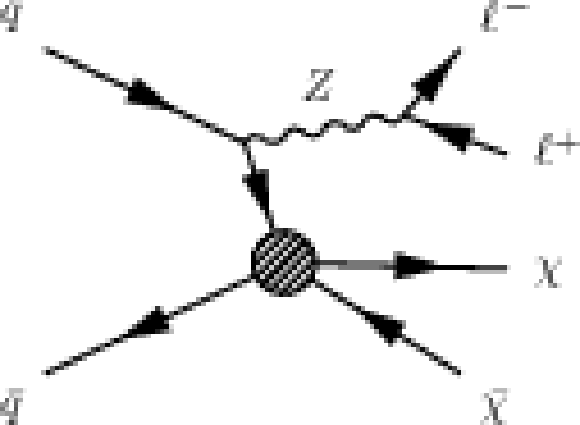
png pdf |
Figure 1-a:
The principal Feynman diagrams for the production of DM pairs in association with a Z boson. In (b) and (c) diagrams an additional quark is produced. The hatched circles indicate the interaction modeled with an effective field theory. |
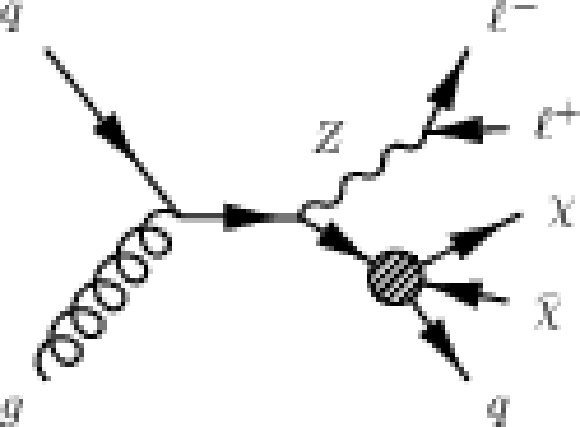
png pdf |
Figure 1-b:
The principal Feynman diagrams for the production of DM pairs in association with a Z boson. In (b) and (c) diagrams an additional quark is produced. The hatched circles indicate the interaction modeled with an effective field theory. |

png pdf |
Figure 1-c:
The principal Feynman diagrams for the production of DM pairs in association with a Z boson. In (b) and (c) diagrams an additional quark is produced. The hatched circles indicate the interaction modeled with an effective field theory. |
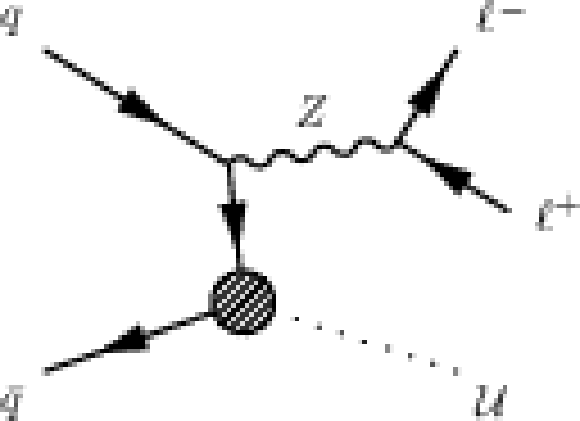
png pdf |
Figure 2-a:
Feynman diagrams for unparticle production in association with a Z boson. The hatched circles indicate the interaction modeled with an effective field theory. |
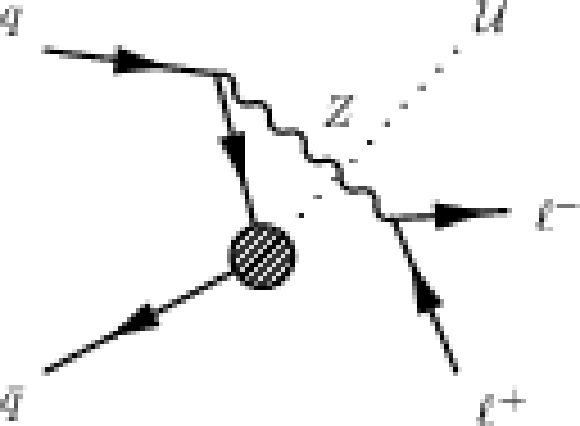
png pdf |
Figure 2-b:
Feynman diagrams for unparticle production in association with a Z boson. The hatched circles indicate the interaction modeled with an effective field theory. |
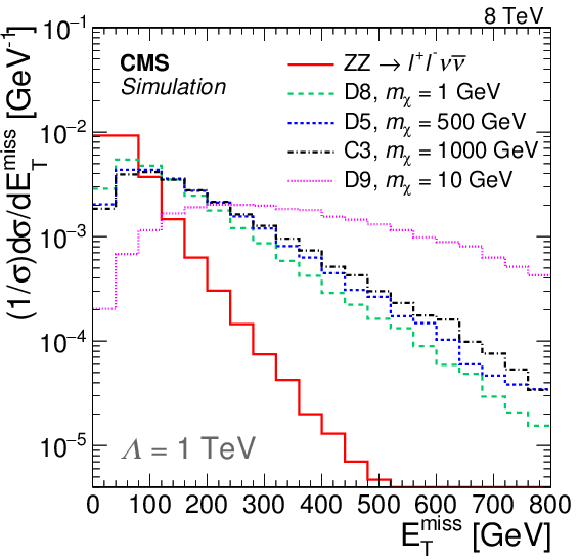
png pdf |
Figure 3-a:
The distribution in ${E_{\mathrm {T}}^{\text {miss}}}$ at the generator level, for DM (a) and unparticle (b) scenarios. The DM curves are shown for different $m_\chi $ with vector (D5), axial-vector (D8), and tensor (D9) coupling for Dirac fermions, and vector (C3) coupling for complex scalar particles. The unparticle curves have the scalar unparticle coupling $\lambda $ between unparticle and SM fields set to 1, with the scaling dimension $d_\mathcal {U}$ ranging from 1.5 to 2.1. The SM background $ {\mathrm{ Z } } {\mathrm{ Z } } \to \ell ^{-}\ell ^{+}\nu \bar{\nu} $ is shown as a red solid curve. |
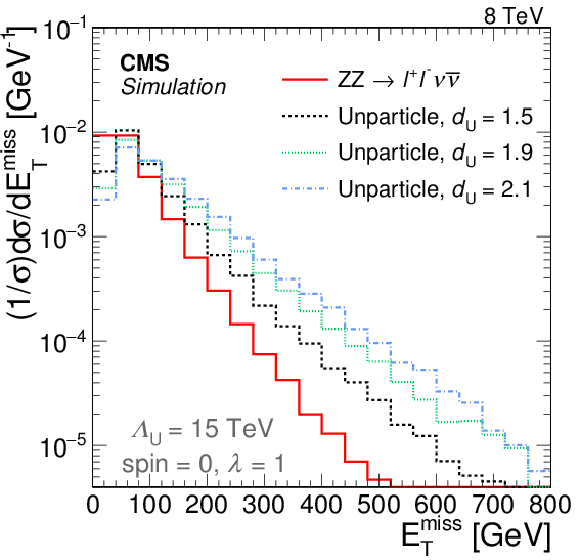
png pdf |
Figure 3-b:
The distribution in ${E_{\mathrm {T}}^{\text {miss}}}$ at the generator level, for DM (a) and unparticle (b) scenarios. The DM curves are shown for different $m_\chi $ with vector (D5), axial-vector (D8), and tensor (D9) coupling for Dirac fermions, and vector (C3) coupling for complex scalar particles. The unparticle curves have the scalar unparticle coupling $\lambda $ between unparticle and SM fields set to 1, with the scaling dimension $d_\mathcal {U}$ ranging from 1.5 to 2.1. The SM background $ {\mathrm{ Z } } {\mathrm{ Z } } \to \ell ^{-}\ell ^{+}\nu \bar{\nu} $ is shown as a red solid curve. |
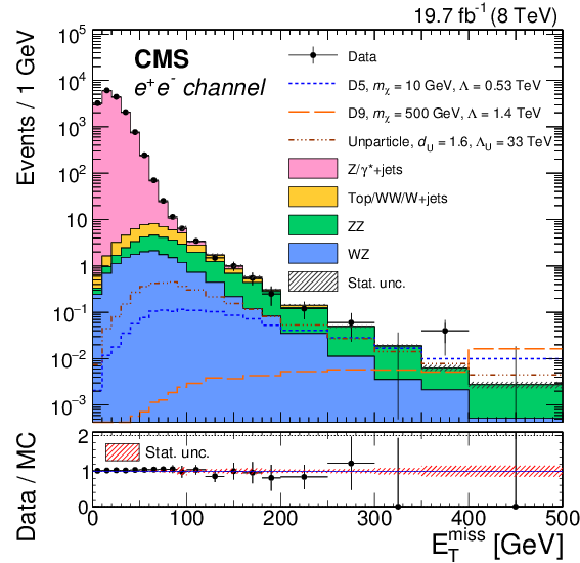
png pdf |
Figure 4-a:
The distribution of ${E_{\mathrm {T}}^{\text {miss}}}$ after preselection for the $ {\mathrm{ Z } } \to \mathrm{ e }^- \mathrm{ e }^+ $ (a) and $ {\mathrm{ Z } } \to \mu^+ \mu^- $ (b) channels. Expected signal distributions are shown for Dirac fermions with vector or tensor couplings and for unparticles. The total statistical uncertainty in the overall background is shown as a hatched region. The horizontal bars on the data points indicate the bin width. Overflow events are included in the rightmost bins. |

png pdf |
Figure 4-b:
The distribution of ${E_{\mathrm {T}}^{\text {miss}}}$ after preselection for the $ {\mathrm{ Z } } \to \mathrm{ e }^- \mathrm{ e }^+ $ (a) and $ {\mathrm{ Z } } \to \mu^+ \mu^- $ (b) channels. Expected signal distributions are shown for Dirac fermions with vector or tensor couplings and for unparticles. The total statistical uncertainty in the overall background is shown as a hatched region. The horizontal bars on the data points indicate the bin width. Overflow events are included in the rightmost bins. |
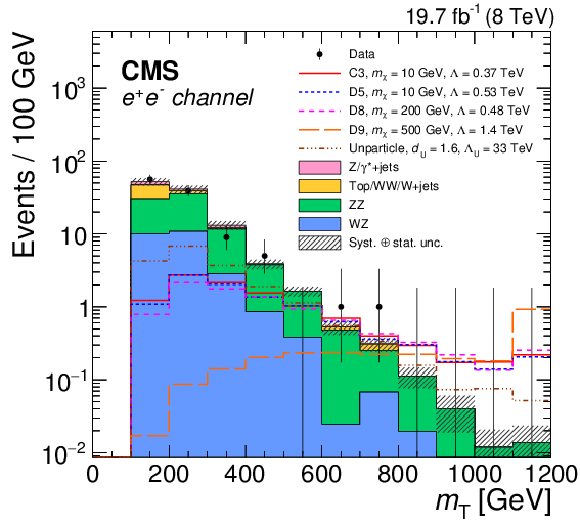
png pdf |
Figure 5-a:
Distributions of the transverse mass for the final selection in the $\mathrm{ e }^- \mathrm{ e }^+ $ (a) and $\mu^+ \mu^- $ (b) channels. Examples of expected signal distributions are shown for DM particle production and unparticle production. The total statistical and systematic uncertainty in the overall background is shown as a hatched region. Overflow events are included in the rightmost bins. |
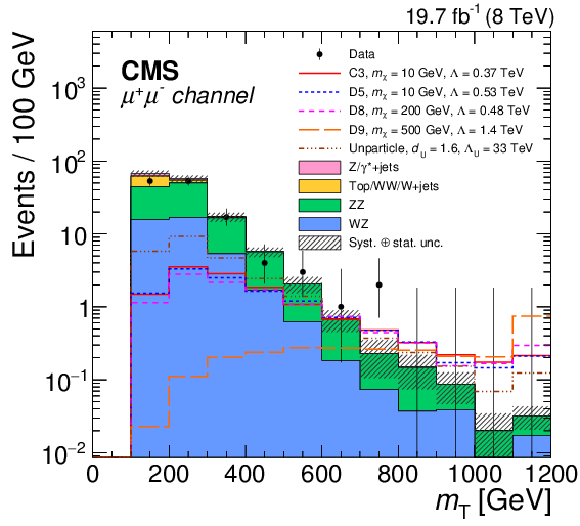
png pdf |
Figure 5-b:
Distributions of the transverse mass for the final selection in the $\mathrm{ e }^- \mathrm{ e }^+ $ (a) and $\mu^+ \mu^- $ (b) channels. Examples of expected signal distributions are shown for DM particle production and unparticle production. The total statistical and systematic uncertainty in the overall background is shown as a hatched region. Overflow events are included in the rightmost bins. |
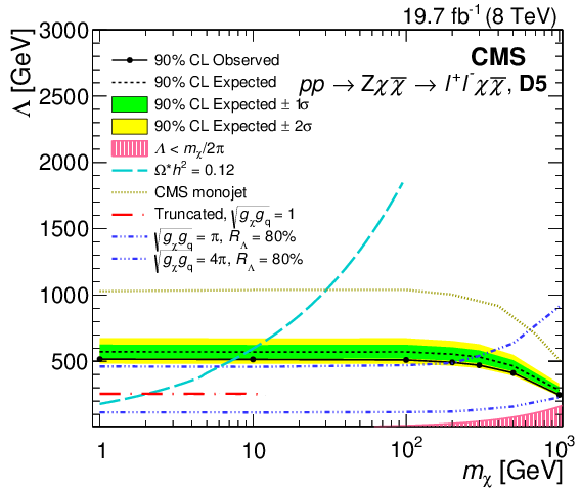
png pdf |
Figure 6-a:
Expected and observed 90% CL lower limits on $\Lambda $ as a function of DM particle mass $m_{\chi }$ for the operators D5 (a), D8 (b), D9 (c), and C3 (d). The pink shaded area is shown in each plot to indicate the lower bound $\Lambda > m_{\chi }/2\pi $ on the validity of the effective field theory DM model. The cyan long-dashed line calculated by MadDM1.0 [82] reflects the relic density of cold, nonbaryonic DM: $\Omega h^2= $ 0.1198 $\pm$ 0.0026 measured by the Planck telescope [81]. Monojet results from CMS [14] are shown for comparison. Truncated limits with $\sqrt {g_\mathrm{ q } g_\chi }= $ 1 are presented with red dot long-dashed lines. The blue double-dot and triple-dot dashed lines indicate the contours of $R_{\Lambda }=80%$ for all operators with couplings $\sqrt {g_\mathrm{ q } g_\chi }=\pi $ and $4\pi $. |
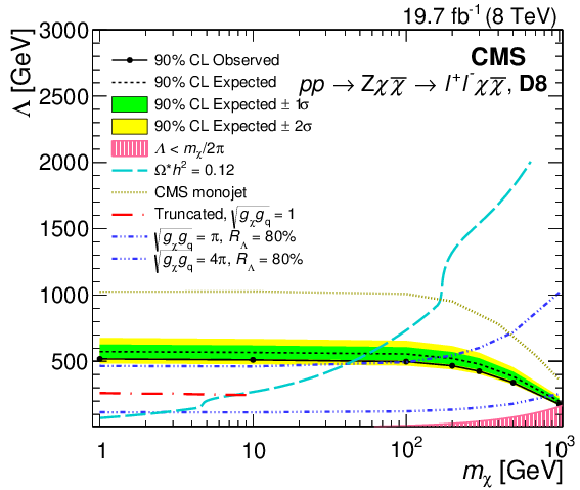
png pdf |
Figure 6-b:
Expected and observed 90% CL lower limits on $\Lambda $ as a function of DM particle mass $m_{\chi }$ for the operators D5 (a), D8 (b), D9 (c), and C3 (d). The pink shaded area is shown in each plot to indicate the lower bound $\Lambda > m_{\chi }/2\pi $ on the validity of the effective field theory DM model. The cyan long-dashed line calculated by MadDM1.0 [82] reflects the relic density of cold, nonbaryonic DM: $\Omega h^2= $ 0.1198 $\pm$ 0.0026 measured by the Planck telescope [81]. Monojet results from CMS [14] are shown for comparison. Truncated limits with $\sqrt {g_\mathrm{ q } g_\chi }= $ 1 are presented with red dot long-dashed lines. The blue double-dot and triple-dot dashed lines indicate the contours of $R_{\Lambda }=80%$ for all operators with couplings $\sqrt {g_\mathrm{ q } g_\chi }=\pi $ and $4\pi $. |
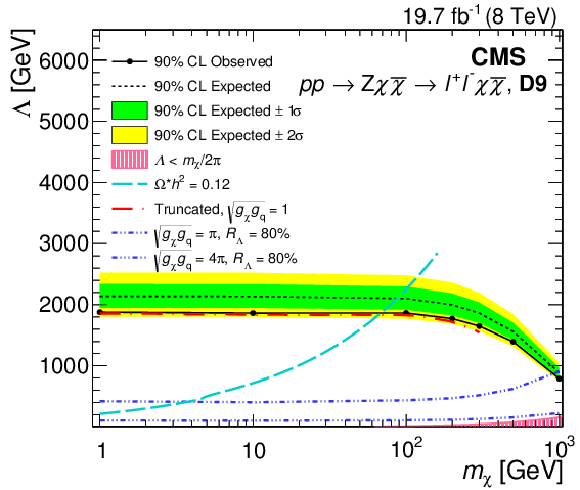
png pdf |
Figure 6-c:
Expected and observed 90% CL lower limits on $\Lambda $ as a function of DM particle mass $m_{\chi }$ for the operators D5 (a), D8 (b), D9 (c), and C3 (d). The pink shaded area is shown in each plot to indicate the lower bound $\Lambda > m_{\chi }/2\pi $ on the validity of the effective field theory DM model. The cyan long-dashed line calculated by MadDM1.0 [82] reflects the relic density of cold, nonbaryonic DM: $\Omega h^2= $ 0.1198 $\pm$ 0.0026 measured by the Planck telescope [81]. Monojet results from CMS [14] are shown for comparison. Truncated limits with $\sqrt {g_\mathrm{ q } g_\chi }= $ 1 are presented with red dot long-dashed lines. The blue double-dot and triple-dot dashed lines indicate the contours of $R_{\Lambda }=80%$ for all operators with couplings $\sqrt {g_\mathrm{ q } g_\chi }=\pi $ and $4\pi $. |
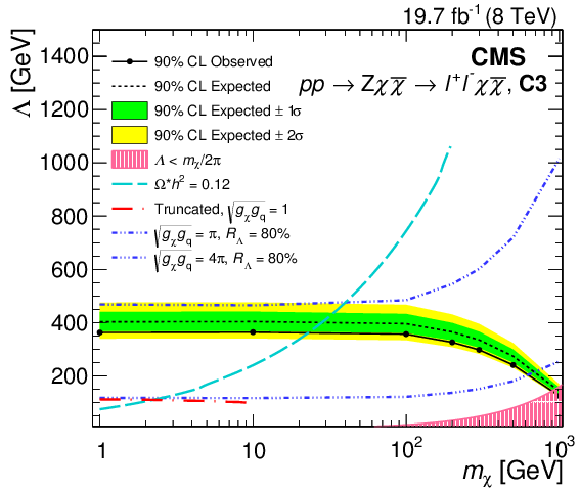
png pdf |
Figure 6-d:
Expected and observed 90% CL lower limits on $\Lambda $ as a function of DM particle mass $m_{\chi }$ for the operators D5 (a), D8 (b), D9 (c), and C3 (d). The pink shaded area is shown in each plot to indicate the lower bound $\Lambda > m_{\chi }/2\pi $ on the validity of the effective field theory DM model. The cyan long-dashed line calculated by MadDM1.0 [82] reflects the relic density of cold, nonbaryonic DM: $\Omega h^2= $ 0.1198 $\pm$ 0.0026 measured by the Planck telescope [81]. Monojet results from CMS [14] are shown for comparison. Truncated limits with $\sqrt {g_\mathrm{ q } g_\chi }= $ 1 are presented with red dot long-dashed lines. The blue double-dot and triple-dot dashed lines indicate the contours of $R_{\Lambda }=80%$ for all operators with couplings $\sqrt {g_\mathrm{ q } g_\chi }=\pi $ and $4\pi $. |

png pdf |
Figure 7-a:
The 90%CL upper limits on the DM-nucleon cross section as a function of the DM particle mass. a: spin-dependent limits for axial-vector (D8) and tensor (D9) coupling of Dirac fermion DM candidates, together with direct search experimental results from the PICO [101], XENON100 [102], and IceCube [7] collaborations. b: spin-independent limits for vector coupling of complex scalar (C3) and Dirac fermion (D5) DM candidates, together with CDMSlite [8], LUX [11], as well as Higgs-portal scalar DM results from CMS [96] with central (solid), minimum (dashed) and maximum (dot dashed) values of Higgs-nucleon couplings. Collider results from CMS monojet [14] and monophoton [16] searches, interpreted in both spin-dependent and spin-independent scenarios, are shown for comparison. The truncated limits for D5, D8, D9, and C3 with $\sqrt {g_\mathrm{ q } g_\chi }= $ 1 are presented with dashed lines in same shade as the untruncated ones. |

png pdf |
Figure 7-b:
The 90%CL upper limits on the DM-nucleon cross section as a function of the DM particle mass. a: spin-dependent limits for axial-vector (D8) and tensor (D9) coupling of Dirac fermion DM candidates, together with direct search experimental results from the PICO [101], XENON100 [102], and IceCube [7] collaborations. b: spin-independent limits for vector coupling of complex scalar (C3) and Dirac fermion (D5) DM candidates, together with CDMSlite [8], LUX [11], as well as Higgs-portal scalar DM results from CMS [96] with central (solid), minimum (dashed) and maximum (dot dashed) values of Higgs-nucleon couplings. Collider results from CMS monojet [14] and monophoton [16] searches, interpreted in both spin-dependent and spin-independent scenarios, are shown for comparison. The truncated limits for D5, D8, D9, and C3 with $\sqrt {g_\mathrm{ q } g_\chi }= $ 1 are presented with dashed lines in same shade as the untruncated ones. |
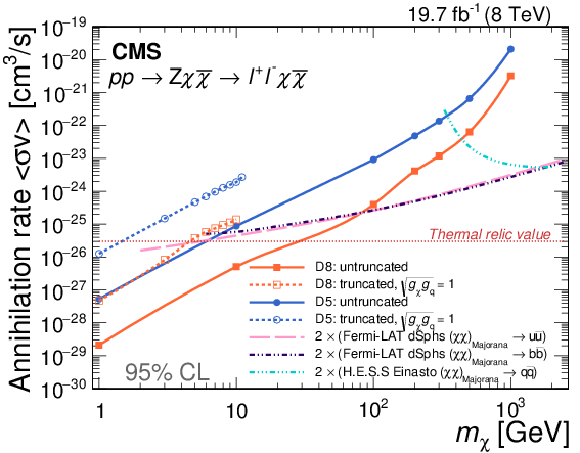
png pdf |
Figure 8:
The 95%CL upper limits on the DM annihilation rate $< \sigma v> $ for $\chi \overline {\chi } \to \mathrm{ q } \mathrm{ \bar{q} } $ as a function of the DM particle mass for vector (D5) and axial-vector (D8) couplings of Dirac fermion DM. A 100% branching fraction of DM annihilating to quarks is assumed. Indirect search experimental results from H.E.S.S [103] and Fermi-LAT [104] are also plotted. The value required for DM particles to account for the relic abundance is labeled ``Thermal relic value'' and is shown as a red dotted line. The truncated limits for D5 and D8 with $\sqrt {g_\mathrm{ q } g_\chi }= $ 1 are presented with dashed lines in same shade as the untruncated ones. |
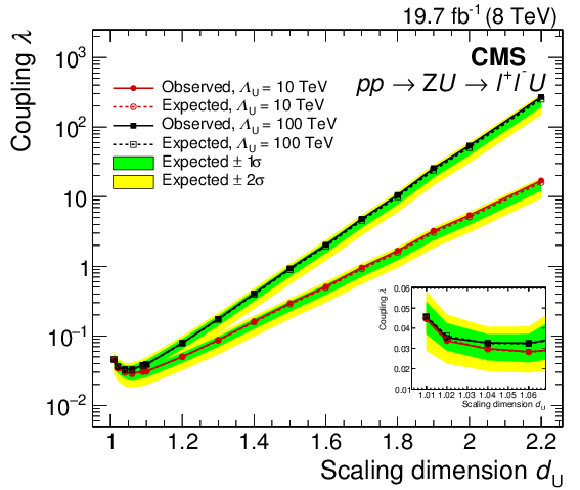
png pdf |
Figure 9-a:
Left: 95% CL upper limits on the coupling $\lambda $ between the unparticle and SM fields with fixed effective cutoff scales $\Lambda _\mathcal {U}= $ 10 and 100 TeV . The plot inserted provides an expanded view of the limits at low scaling dimension. Right: 95% CL lower limits on unparticle effective cutoff scale $\Lambda _\mathcal {U}$ with a fixed coupling $\lambda = $ 1 . The results from CMS monojet [14] and reinterpretation of LEP searches [37] are also shown for comparison. The excluded region is indicated by the shading. |
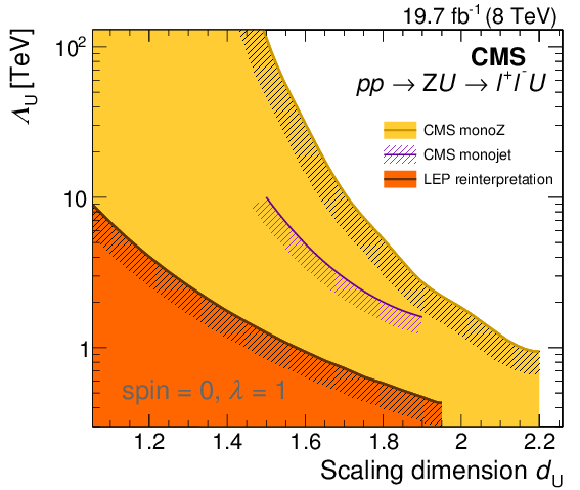
png pdf |
Figure 9-b:
Left: 95% CL upper limits on the coupling $\lambda $ between the unparticle and SM fields with fixed effective cutoff scales $\Lambda _\mathcal {U}= $ 10 and 100 TeV . The plot inserted provides an expanded view of the limits at low scaling dimension. Right: 95% CL lower limits on unparticle effective cutoff scale $\Lambda _\mathcal {U}$ with a fixed coupling $\lambda = $ 1 . The results from CMS monojet [14] and reinterpretation of LEP searches [37] are also shown for comparison. The excluded region is indicated by the shading. |
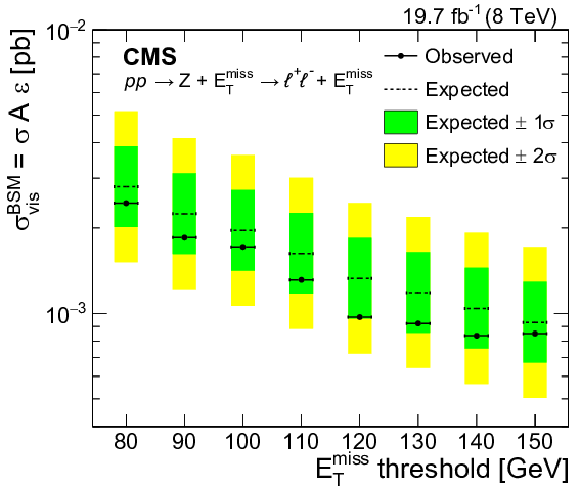
png pdf |
Figure 10:
The model-independent upper limits at 95% CL on the visible cross section ($\sigma A \epsilon $) for BSM production of events, as a function of ${E_{\mathrm {T}}^{\text {miss}}}$ threshold. |
| Tables | |
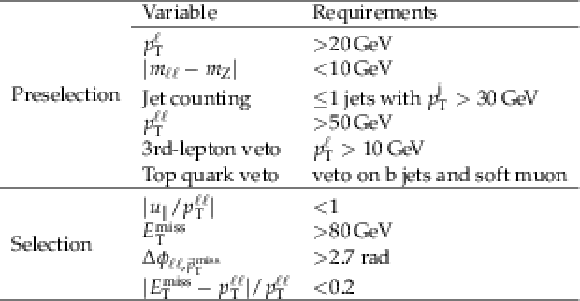
png pdf |
Table 1:
Summary of selections used in the analysis. |
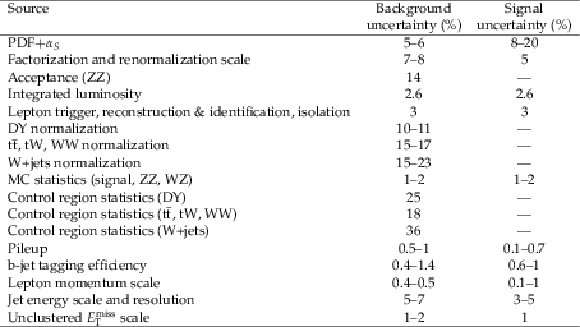
png pdf |
Table 2:
Summary of systematic uncertainties. Each background uncertainty represents the variation of the relative yields of the particular background components. The signal uncertainties represent the relative variations in the signal acceptance, and ranges quoted cover both signals of DM and unparticles with different DM masses or scaling dimensions. For shape uncertainties, the numbers correspond to the overall effect of the shape variation on yield or acceptance. The symbol -- indicates that the systematic uncertainty is not applicable. |

png pdf |
Table 3:
Signal predictions, background estimates, and observed number of events. The DM signal yields are given for masses $m_\chi =$ 10, 200, and 500 GeV and cutoff scales $\Lambda = $ 0.37 , 0.53, 0.48, and 1.4 TeV. The yields from an unparticle signal are presented with a scaling dimension $d_\mathcal {U}= $ 1.6 and a renormalization scale $\Lambda _\mathcal {U}= $ 33 TeV. The corresponding statistical and systematic uncertainties are shown, in that order. |

png pdf |
Table 4:
Expected and observed 90% CL upper limits on the DM-nucleon cross section $\sigma _{\chi N}$ and effective cutoff scale $\Lambda $ for operator D5. |

png pdf |
Table 5:
Expected and observed 90% CL upper limits on the DM-nucleon cross section $\sigma _{\chi N}$ and effective cutoff scale $\Lambda $ for operator D8. |

png pdf |
Table 6:
Expected and observed 90% CL upper limits on the DM-nucleon cross section $\sigma _{\chi N}$ and effective cutoff scale $\Lambda $ for operator D9. |

png pdf |
Table 7:
Expected and observed 90% CL upper limits on the DM-nucleon cross section $\sigma _{\chi N}$ and effective cutoff scale $\Lambda $ for operator C3. |
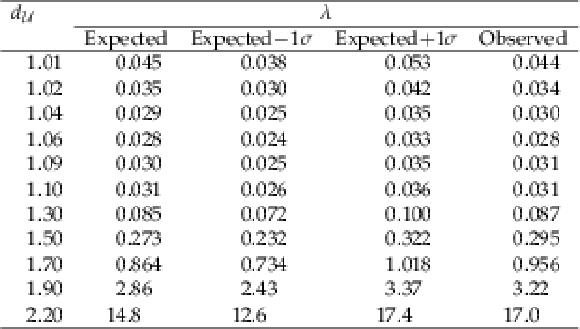
png pdf |
Table 8:
Expected and observed 95% CL upper limits on the coupling $\lambda $ between unparticles and the SM fields, for values of $d_\mathcal {U}$ in the range from 1.01 to 2.20 and a fixed effective cutoff scale $\Lambda _\mathcal {U}= $ 10 TeV. |

png pdf |
Table 9:
Expected and observed 95% CL upper limits on the coupling $\lambda $ between unparticles and the SM fields, for values of $d_\mathcal {U}$ in the range from 1.01 to 2.20 and a fixed effective cutoff scale $\Lambda _\mathcal {U}= $ 100 TeV. |
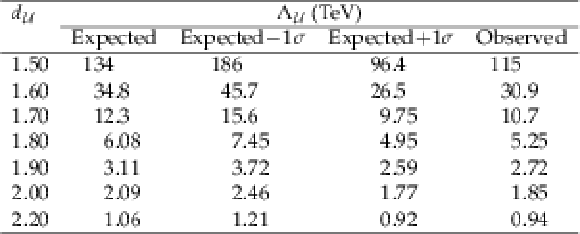
png pdf |
Table 10:
Expected and observed 95% CL lower limits on the effective cutoff scale $\Lambda _\mathcal {U}$ for values of $d_\mathcal {U}$ in the range from 1.60 to 2.20 and a fixed coupling $\lambda = $ 1 . |

png pdf |
Table 11:
Total SM background predictions for the numbers of events passing the selection requirements, for different ${E_{\mathrm {T}}^{\text {miss}}}$ thresholds, compared with the observed numbers of events. The listed uncertainties include both statistical and systematic components. The 95% CL observed and expected upper limits for the contribution of events from BSM sources are also shown. The ${\pm }1\sigma $ and ${\pm }2\sigma $ excursions from expected limits are also given. |
| Summary |
| A search for evidence for particle dark matter and unparticle production at the LHC has been performed in events containing two charged leptons, consistent with the decay of a Z boson, and large missing transverse momentum. The study is based on a data set corresponding to an integrated luminosity of 19.7 fb$^{-1}$ of pp collisions collected by the CMS detector at a center-of-mass energy of 8 TeV. The results are consistent with the expected standard model contributions. These results are interpreted in two scenarios for physics beyond the standard model: dark matter and unparticles. Model-independent 95% confidence level upper limits are also set on contributions to the visible Z+$E_{\mathrm{T}}^\text{miss}$ cross section from sources beyond the standard model. Upper limits at 90% confidence level are set on the DM-nucleon scattering cross sections as a function of DM particle mass for both spin-dependent and spin-independent cases. Limits are also set on the DM annihilation rate assuming a branching fraction of 100% for annihilation to quarks, and on the effective cutoff scale. In addition, the most stringent limits to date at 95% confidence level on the coupling between unparticles and the standard model fields as well as the effective cutoff scale as a function of the unparticle scaling dimension are obtained in this analysis. |
| References | ||||
| 1 | R. W. Tucker and C. Wang | Dark matter gravitational interactions | Class. Quant. Grav. 15 (1998) 933 | gr-qc/9612019 |
| 2 | M. Lopez-Corredoira, J. E. Beckman, and E. Casuso | High-velocity clouds as dark matter in the local group | AA 351 (1999) 920 | astro-ph/9909389 |
| 3 | D. Clowe et al. | A Direct Empirical Proof of The Existence of Dark Matter | AJ 648 (2006) 109 | astro-ph/0608407 |
| 4 | PICASSO Collaboration | Constraints on low-mass WIMP interactions on $ ^{19} $F from PICASSO | PLB 711 (2012) 153 | 1202.1240 |
| 5 | SIMPLE Collaboration | Final Analysis and Results of the Phase II SIMPLE Dark Matter Search | PRL 108 (2012) 201302 | 1106.3014 |
| 6 | COUPP Collaboration | First dark matter search results from a 4-kg CF$ _3 $I Bubble Chamber Operated in a Deep Underground site | PRD 86 (2012) 052001 | 1204.3094 |
| 7 | IceCube Collaboration | Multi-year search for dark matter annihilations in the Sun with the AMANDA-II and IceCube detectors | PRD 85 (2012) 042002 | 1112.1840 |
| 8 | SuperCDMS Collaboration | Search for Low-Mass Weakly Interacting Massive Particles Using Voltage-Assisted Calorimetric Ionization Detection in the SuperCDMS Experiment | PRL 112 (2014) 041302 | 1309.3259 |
| 9 | P. Cushman et al. | Snowmass CF1 Summary: WIMP Dark Matter Direct Detection | 1310.8327 | |
| 10 | SuperCDMS Collaboration | Search for Low-Mass WIMPs with SuperCDMS | PRL 112 (2014) 241302 | 1402.7137 |
| 11 | LUX Collaboration | First Results from the LUX Dark Matter Experiment at the Sanford Underground Research Facility | PRL 112 (2014) 091303 | 1310.8214 |
| 12 | Fermi-LAT Collaboration | Constraining Dark Matter Models from a Combined Analysis of Milky Way Satellites with the Fermi Large Area Telescope | PRL 107 (2011) 241302 | 1108.3546 |
| 13 | J. Buckley et al. | Indirect Dark Matter Detection CF2 Working Group Summary | 1310.7040 | |
| 14 | CMS Collaboration | Search for dark matter, extra dimensions, and unparticles in monojet events in proton-proton collisions at $ \sqrt{s} $ = 8 TeV | EPJC 75 (2015) 235 | CMS-EXO-12-048 1408.3583 |
| 15 | ATLAS Collaboration | Search for new phenomena in final states with an energetic jet and large missing transverse momentum in pp collisions at $ \sqrt{s}=8~ $ TeV with the ATLAS detector | EPJC 75 (2015) 299 | 1502.01518 |
| 16 | CMS Collaboration | Search for new phenomena in monophoton final states in proton-proton collisions at $ \sqrt{s} $ = 8 TeV | PLB 755 (2016) 102 | CMS-EXO-12-047 1410.8812 |
| 17 | ATLAS Collaboration | Search for new phenomena in events with a photon and missing transverse momentum in pp collisions at $ \sqrt{s}=8 $ TeV with the ATLAS detector | PRD 91 (2015) 012008 | 1411.1559 |
| 18 | CMS Collaboration | Search for physics beyond the standard model in final states with a lepton and missing transverse energy in proton-proton collisions at $ \sqrt{s} $ = 8 TeV | PRD 91 (2015) 092005 | CMS-EXO-12-060 1408.2745 |
| 19 | ATLAS Collaboration | Search for dark matter in events with heavy quarks and missing transverse momentum in pp collisions with the ATLAS detector | EPJC 75 (2015) 92 | 1410.4031 |
| 20 | ATLAS Collaboration | Search for dark matter in events with a hadronically decaying W or Z boson and missing transverse momentum in pp collisions at $ \sqrt{s} $ = 8 TeV with the ATLAS detector | PRL 112 (2014) 041802 | 1309.4017 |
| 21 | ATLAS Collaboration | Search for new particles in events with one lepton and missing transverse momentum in pp collisions at $ \sqrt{s} $ = 8 TeV with the ATLAS detector | JHEP 09 (2014) 037 | 1407.7494 |
| 22 | ATLAS Collaboration | Search for invisible particles produced in association with single-top-quarks in proton-proton collisions at $ \sqrt{s} $ = 8 TeV with the ATLAS detector | EPJC 75 (2015) 79 | 1410.5404 |
| 23 | ATLAS Collaboration | Search for Dark Matter in Events with Missing Transverse Momentum and a Higgs Boson Decaying to Two Photons in $ pp $ Collisions at $ \sqrt{s}=8 $ TeV with the ATLAS Detector | PRL 115 (2015) 131801 | 1506.01081 |
| 24 | CMS Collaboration | Search for Monotop Signatures in Proton-Proton Collisions at $ \sqrt{s}=8 $ TeV | PRL 114 (2015) 101801 | CMS-B2G-12-022 1410.1149 |
| 25 | CMS Collaboration | Search for the production of dark matter in association with top-quark pairs in the single-lepton final state in proton-proton collisions at $ \sqrt{s} $ = 8 TeV | JHEP 06 (2015) 121 | CMS-B2G-14-004 1504.03198 |
| 26 | ATLAS Collaboration | Search for dark matter in events with a Z boson and missing transverse momentum in pp collisions at $ \sqrt{s} $ = 8 TeV with the ATLAS detector | PRD 90 (2014) 012004 | 1404.0051 |
| 27 | L. M. Carpenter et al. | Collider searches for dark matter in events with a Z boson and missing energy | PRD 87 (2013) 074005 | 1212.3352 |
| 28 | J. Goodman et al. | Constraints on dark matter from colliders | PRD 82 (2010) 116010 | 1008.1783 |
| 29 | H. Georgi | Unparticle physics | PRL 98 (2007) 221601 | hep-ph/0703260 |
| 30 | H. Georgi | Another odd thing about unparticle physics | PLB 650 (2007) 275 | 0704.2457 |
| 31 | K. Cheung, W.-Y. Keung, and T.-C. Yuan | Collider signals of unparticle physics | PRL 99 (2007) 051803 | 0704.2588 |
| 32 | K. Cheung, W.-Y. Keung, and T.-C. Yuan | Collider Phenomenology of Unparticle Physics | PRD 76 (2007) 055003 | 0706.3155 |
| 33 | Z. Kang | Upgrading sterile neutrino dark matter to FImP using scale invariance | EPJC 75 (2015) 471 | 1411.2773 |
| 34 | M. Rinaldi, G. Cognola, L. Vanzo, and S. Zerbini | Inflation in scale-invariant theories of gravity | PRD 91 (2015) 123527 | 1410.0631 |
| 35 | H. Cheng | The Possible Existence of Weyl's Vector Meson | PRL 61 (1988) 2182 | |
| 36 | T. Banks and A. Zaks | On the phase structure of vector-like gauge theories with massless fermions | Nucl. Phys. B 196 (1982) 189 | |
| 37 | S. Kathrein, S. Knapen, and M. J. Strassler | Bounds from LEP on unparticle interactions with electroweak bosons | PRD 84 (2011) 015010 | 1012.3737 |
| 38 | CMS Collaboration | CMS Luminosity Based on Pixel Cluster Counting - Summer 2013 Update | CMS-PAS-LUM-13-001 | CMS-PAS-LUM-13-001 |
| 39 | CMS Collaboration | The CMS experiment at the CERN LHC | JINST 3 (2008) S08004 | CMS-00-001 |
| 40 | CMS Collaboration | Performance of electron reconstruction and selection with the CMS detector in proton-proton collisions at $ \sqrt{s} $ = 8 TeV | JINST 10 (2015) 06005 | CMS-EGM-13-001 1502.02701 |
| 41 | CMS Collaboration | Performance of CMS muon reconstruction in pp collision events at $ \sqrt{s} $ = 7 TeV | JINST 7 (2012) 10002 | CMS-MUO-10-004 1206.4071 |
| 42 | J. Alwall et al. | The automated computation of tree-level and next-to-leading order differential cross sections, and their matching to parton shower simulations | JHEP 07 (2014) 079 | 1405.0301 |
| 43 | T. Sj\"ostrand, S. Mrenna, and P. Skands | PYTHIA 6.4 physics and manual | JHEP 05 (2006) 026 | hep-ph/0603175 |
| 44 | J. Pumplin et al. | New generation of parton distributions with uncertainties from global QCD analysis | JHEP 07 (2002) 012 | hep-ph/0201195 |
| 45 | R. Field | Early LHC Underlying Event Data - Findings and Surprises | in Hadron collider physics. Proceedings, 22nd Conference, HCP 2010, Toronto, Canada, 2010 | 1010.3558 |
| 46 | T. Sj\"ostrand, S. Mrenna, and P. Z. Skands | A brief introduction to PYTHIA 8.1 | CPC 178 (2008) 852 | 0710.3820 |
| 47 | S. Ask | Simulation of $ Z $ plus graviton/unparticle production at the LHC | EPJC 60 (2009) 509 | 0809.4750 |
| 48 | S. Ask et al. | Real emission and virtual exchange of gravitons and unparticles in PYTHIA8 | CPC 181 (2010) 1593 | 0912.4233 |
| 49 | R. Corke and T. Sj\"ostrand | Interleaved parton showers and tuning prospects | JHEP 03 (2011) 032 | 1011.1759 |
| 50 | P. Nason | A New method for combining NLO QCD with shower Monte Carlo algorithms | JHEP 11 (2004) 040 | hep-ph/0409146 |
| 51 | S. Frixione, P. Nason, and C. Oleari | Matching NLO QCD computations with Parton Shower simulations: the POWHEG method | JHEP 11 (2007) 070 | 0709.2092 |
| 52 | S. Alioli, P. Nason, C. Oleari, and E. Re | A general framework for implementing NLO calculations in shower Monte Carlo programs: the POWHEG BOX | JHEP 06 (2010) 043 | 1002.2581 |
| 53 | E. Re | Single-top $ W $$ t $-channel production matched with parton showers using the POWHEG method | EPJC 71 (2011) 1547 | 1009.2450 |
| 54 | S. Alioli, S.-O. Moch, and P. Uwer | Hadronic top-quark pair-production with one jet and parton showering | JHEP 01 (2012) 137 | 1110.5251 |
| 55 | J. Alwall et al. | MadGraph/MadEvent v4: the new web generation | JHEP 09 (2007) 028 | 0706.2334 |
| 56 | H.-L. Lai et al. | Uncertainty induced by QCD coupling in the CTEQ global analysis of parton distributions | PRD 82 (2010) 054021 | 1004.4624 |
| 57 | H.-L. Lai et al. | New parton distributions for collider physics | PRD 82 (2010) 074024 | 1007.2241 |
| 58 | GEANT4 Collaboration | GEANT4---a simulation toolkit | NIMA 506 (2003) 250 | |
| 59 | CMS Collaboration | Particle--Flow Event Reconstruction in CMS and Performance for Jets, Taus, and $ E_{\mathrm{T}}^{\text{miss}} $ | CMS-PAS-PFT-09-001 | |
| 60 | CMS Collaboration | Commissioning of the Particle-flow Event Reconstruction with the first LHC collisions recorded in the CMS detector | CMS-PAS-PFT-10-001 | |
| 61 | M. Cacciari and G. P. Salam | Pileup subtraction using jet areas | PLB 659 (2008) 119 | 0707.1378 |
| 62 | M. Cacciari, G. P. Salam, and G. Soyez | The anti-$ k_t $ jet clustering algorithm | JHEP 04 (2008) 063 | 0802.1189 |
| 63 | M. Cacciari, G. P. Salam, and G. Soyez | FastJet user manual | EPJC 72 (2012) 1896 | 1111.6097 |
| 64 | M. Cacciari and G. P. Salam | Dispelling the $ N^{3} $ myth for the $ k_{t} $ jet-finder | PLB 641 (2006) 57 | hep-ph/0512210 |
| 65 | CMS Collaboration | Determination of jet energy calibration and transverse momentum resolution in CMS | JINST 6 (2011) P11002 | CMS-JME-10-011 1107.4277 |
| 66 | CMS Collaboration | Identification of b-quark jets with the CMS experiment | JINST 8 (2013) 04013 | CMS-BTV-12-001 1211.4462 |
| 67 | CMS Collaboration | Performance of b tagging at $ \sqrt{s} $ = 8 TeV in multijet, ttbar and boosted topology events | CMS-PAS-BTV-13-001 | CMS-PAS-BTV-13-001 |
| 68 | J. M. Campbell and R. K. Ellis | MCFM for the Tevatron and the LHC | NPPS 205 (2010) 10 | 1007.3492 |
| 69 | CMS Collaboration | Measurement of the inclusive $ W $ and $ Z $ production cross sections in pp collisions at $ \sqrt{s}=7 $ TeV | JHEP 10 (2011) 132 | CMS-EWK-10-005 1107.4789 |
| 70 | S. Alekhin et al. | The PDF4LHC Working Group Interim Report | 1101.0536 | |
| 71 | M. Botje et al. | The PDF4LHC Working Group Interim Recommendations | 1101.0538 | |
| 72 | NNPDF Collaboration | Parton distributions with LHC data | NPB 867 (2013) 244 | 1207.1303 |
| 73 | P. M. Nadolsky et al. | Implications of CTEQ global analysis for collider observables | PRD 78 (2008) 013004 | 0802.0007 |
| 74 | A. D. Martin, W. J. Stirling, R. S. Thorne, and G. Watt | Parton distributions for the LHC | EPJC 63 (2009) 189 | 0901.0002 |
| 75 | P. Nason and G. Zanderighi | $ W^+ W^- $ , $ W Z $ and $ Z Z $ production in the POWHEG-BOX-V2 | EPJC 74 (2014) 2702 | 1311.1365 |
| 76 | T. Gleisberg et al. | Event generation with SHERPA 1.1 | JHEP 02 (2009) 007 | 0811.4622 |
| 77 | A. L. Read | Presentation of search results: the $ CL_{s} $ technique | JPG 28 (2002) 2693 | |
| 78 | T. Junk | Confidence level computation for combining searches with small statistics | NIMA 434 (1999) 435 | hep-ex/9902006 |
| 79 | G. Cowan, K. Cranmer, E. Gross, and O. Vitells | Asymptotic formulae for likelihood-based tests of new physics | EPJC 71 (2011) 1554, , [Erratum: \DOI10.1140/epjc/s10052-013-2501-z] | 1007.1727 |
| 80 | ATLAS and CMS Collaborations, LHC Higgs Combination Group | Procedure for the LHC Higgs boson search combination in Summer 2011 | ATL-PHYS-PUB-2011-11, CMS-NOTE-2011-005 | |
| 81 | Planck Collaboration | Planck 2013 results. XVI. Cosmological parameters | AA 571 (2014) A16 | 1303.5076 |
| 82 | M. Backovi\'c, K. Kong, and M. McCaskey | MadDM v.1.0: Computation of dark matter relic abundance using MadGraph5 | Physics of the Dark Universe 5 (2014) 18 | 1308.4955 |
| 83 | Y. Bai, P. J. Fox, and R. Harnik | The Tevatron at the frontier of dark matter direct detection | JHEP 12 (2010) 048 | 1005.3797 |
| 84 | A. Friedland, M. L. Graesser, I. M. Shoemaker, and L. Vecchi | Probing nonstandard standard model backgrounds with LHC monojets | PLB 714 (2012) 267 | 1111.5331 |
| 85 | O. Buchmueller, M. J. Dolan, and C. McCabe | Beyond effective field theory for dark matter searches at the LHC | JHEP 01 (2014) 025 | 1308.6799 |
| 86 | P. J. Fox, R. Harnik, J. Kopp, and Y. Tsai | Missing energy signatures of dark matter at the LHC | PRD 85 (2012) 056011 | 1109.4398 |
| 87 | J. Goodman and W. Shepherd | LHC Bounds on UV-Complete Models of Dark Matter | 1111.2359 | |
| 88 | I. M. Shoemaker and L. Vecchi | Unitarity and monojet bounds on models for DAMA, CoGeNT, and CRESST-II | PRD 86 (2012) 015023 | 1112.5457 |
| 89 | G. Busoni, A. De Simone, E. Morgante, and A. Riotto | On the validity of the effective field theory for dark matter searches at the LHC | PLB 728 (2014) 412 | 1307.2253 |
| 90 | G. Busoni et al. | On the validity of the effective field theory for dark matter searches at the LHC, part II: complete analysis for the $ s $-channel | JCAP 06 (2014) 060 | 1402.1275 |
| 91 | G. Busoni et al. | On the Validity of the Effective Field Theory for Dark Matter Searches at the LHC Part III: Analysis for the $ t $-channel | JCAP 09 (2014) 022 | 1405.3101 |
| 92 | S. Malik et al. | Interplay and Characterization of Dark Matter Searches at Colliders and in Direct Detection Experiments | Physics of the Dark Universe 9--10 (2015) 51 | 1409.4075 |
| 93 | J. Abdallah et al. | Simplified models for dark matter searches at the LHC | Physics of the Dark Universe 9 (2015) 8 | 1506.03116 |
| 94 | D. Abercrombie et al. | Dark Matter Benchmark Models for Early LHC Run-2 Searches: Report of the ATLAS/CMS Dark Matter Forum | 1507.00966 | |
| 95 | G. Belanger, F. Boudjema, A. Pukhov, and A. Semenov | Dark matter direct detection rate in a generic model with micrOMEGAs 2.2 | CPC 180 (2009) 747 | 0803.2360 |
| 96 | CMS Collaboration | Search for invisible decays of Higgs bosons in the vector boson fusion and associated ZH production modes | EPJC 74 (2014) 2980 | CMS-HIG-13-030 1404.1344 |
| 97 | A. Djouadi, O. Lebedev, Y. Mambrini, and J. Quevillon | Implications of LHC searches for Higgs--portal dark matter | PLB 709 (2012) 65 | 1112.3299 |
| 98 | A. Djouadi, A. Falkowski, Y. Mambrini, and J. Quevillon | Direct detection of Higgs-portal dark matter at the LHC | EPJC 73 (2013) 2455 | 1205.3169 |
| 99 | R. D. Young and A. W. Thomas | Octet baryon masses and sigma terms from an SU(3) chiral extrapolation | PRD 81 (2010) 014503 | 0901.3310 |
| 100 | MILC Collaboration | The Strange Quark Condensate in the Nucleon in 2+1 Flavor QCD | PRL 103 (2009) 122002 | 0905.2432 |
| 101 | PICO Collaboration | Dark Matter Search Results from the PICO-2L C$ _3 $F$ _8 $ Bubble Chamber | PRL 114 (2015) 231302 | 1503.00008 |
| 102 | XENON100 Collaboration | Limits on Spin-Dependent WIMP-Nucleon Cross Sections from 225 Live Days of XENON100 Data | PRL 111 (2013) 021301 | 1301.6620 |
| 103 | HESS Collaboration | Constraints on an Annihilation Signal from a Core of Constant Dark Matter Density around the Milky Way Center with H.E.S.S. | PRL 114 (2015) 081301 | 1502.03244 |
| 104 | Fermi-LAT Collaboration | Dark matter constraints from observations of 25 Milky Way satellite galaxies with the Fermi Large Area telescope | PRD 89 (2014) 042001 | 1310.0828 |

|
Compact Muon Solenoid LHC, CERN |

|

|

|

|

|

|